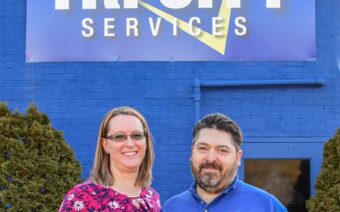
August 5, 2024
AMHERST – For nearly two decades, Northwind Solar has done what it can to provide the best service in the solar industry – a task Jordan Kaiser – who works in solar design and sales – said the company doesn’t take lightly.
“We really embody the cooperative approach, not only with how we do business, but each and every system we design and install,” Kaiser said. “I think that shows… We are seen as one of the industry leaders in our state.”
Though Northwind Solar now specializes in solar power systems for both residential and commercial clientele, he said the company’s story started with wind systems.
A bit of background
Northwind Solar was founded in 2007 by Josh Stolzenburg, who Kaiser said has a background – and passion – in renewable energy.
“He had worked with the Midwest Renewable Energy Association for a span of years and had a history working in the field with wind systems,” he said. “He then brought that knowledge and desire for clean energy to the Stevens Point area and started up a small company… out of a garage with a small office space.”
The first system Northwind Solar designed, however, Kaiser said didn’t have to do with solar – but rather wind.
“That was also the last wind system the company put in,” he said. “That’s in great part due to some of the inherent qualities of wind systems – that there’s moving parts – which can lead to long-term maintenance, making everything a little more challenging.”
Kaiser said back then, Stolzenburg’s idea was to be able to offer “any and all technologies under the umbrella of renewable energy” – including wind systems, solar heating systems, solar electric systems, biomass heating systems and home performance and energy projects.
Around 2014, Kaiser said the company looked at what it was doing best and how it related to the market demand – which was solar electric systems, or solar PV (photovoltaic) systems.
“We (decreased) our service offerings from all those other technologies down to what we do today, which is primarily solar electric or solar power systems for homes and businesses,” he said. “That allowed us to continually achieve high standards in the quality of our workmanship and high-performing systems.”
Zoning in on a niche, Kaiser said, allowed Northwind to become a “more streamlined company, and a stronger company at that.”
“As the market matured and continues to mature, it really set us apart as one of the forefront companies working with this technology – designing and installing these types of systems,” he said. “(It) allowed us to service our local market in a big way for a long time. It really is translated into our success as we sit here today.”

As the company continued to grow, Kaiser said the team began to run out of space at its original location on the west side of Stevens Point.
“We needed more office space for folks on the front end, and we needed more warehouse space for equipment and technicians,” he said.
This led to the decision to move Northwind Solar about 17 miles southeast to Amherst, where the team broke ground on the new space in summer of 2019 and moved in in March 2020.
“That was a big move for us as a company,” he said. “(It) boosted morale in a lot of ways, too – new surroundings, fresh walls to work within and a place to call our own. And I think it certainly helped us in business practices and how we operate.”
Though moving to the new office at the beginning of the COVID-19 pandemic affected Northwind Solar – “like any business” – Kaiser said the company had a strong queue of work in the residential sector.
“Renovation projects were happening for folks, people were making additions to their homes and investing in their homes,” he said. “All of a sudden, you’re home to pay attention to some of these things – and that included solar.”
By being “nimble” and “efficient,” Kaiser said, Northwind was able to be successful through the pandemic – and was even named the 2020 Renewable Energy Business of the Year in Wisconsin by RENEW Wisconsin.
“We learned a lot through that as well…,” he said. “It helped us become a stronger company through it all, like it hopefully did for some other companies out there.”
Worker-owned
Transitioning into a worker-owned company in 2018, Kaiser said, also helped set Northwind apart from others.
The conversation around moving away from the classic vertically integrated model, he said, started back in 2017.
“We saw worker ownership as a more democratic way to do business, not only giving voice to numerous people in our company, but also incentivizing us even more to make sure we’re doing well by our clients and customers,” he said. “Wherein, each one of our jobs – then and now – starts with consultation, design work, estimation, contracting, construction and service. All of that is being done, start to finish, by owners of Northwind Solar.”
Becoming a worker-owned operation, Kaiser said, has helped “fortify our processes and fortify us as a company.”
Services
To put it simply, Kaiser said Northwind designs and installs solar power systems and battery backup systems for homes and businesses.
Under that umbrella, services can range anywhere from solar panel installation and battery backup systems to electric vehicle charging systems.
“We offer all things (related) to solar electric (systems),” he said. “In addition to that, we offer consultation and engineering services.”
The company’s consultation services also allow for workers, such as Kaiser, to educate their clients.
“(We’re) doing work even with utilities these days – on looking at utility skill projects in our area,” he said. “It’s a good feeling to know that the market itself sees us as a resource to go to when exploring these types of projects.”
Kaiser said Northwind Solar’s demographic reach also varies.
“We service an array of clients – everything from small residential systems to small-to-mid-size commercial systems,” he said. “Really anything between 30 kW to one MW is our service offering.”
This, Kaiser said, means projects can range from a small system to a larger one, where Northwind collaborates on the design and project management, pre-built operations and then the actual construction, commissioning and service of that system.
Generally, he said, installation for residential projects can be completed from start to finish within two weeks.
For a larger, commercial system, the process “is certainly longer than that.”
“(It) isn’t a transaction that happens over a couple of days,” he said. “This is a system that we’re going to take time over weeks, months and maybe even years to present solutions, different system sizes and designs, to refine what it is the customer is looking for and find the right fit.”
Kaiser said the systems are designed to last 25-30 years – “so there’s a certain level of follow up down the road.”
“We want to be around and available to customers, whether they have questions or if they have issues with the system – we want to expedite that attention in service,” he said. “(We’re) making sure the customer knows we are there with them for a long time.”
Kaiser said when choosing to install a solar system for a residential or commercial property, it’s important to seek out a local and reputable business.
“I think longevity and reputation are hugely important in deciding on a solar contractor – as well as going local,” he said. “Again, if there’s ever an issue or question with your system, you want to be able to make one phone call and somebody will be there.”
Distributed generation
For anyone who has ever heard someone use the term “rooftop solar,” Kaiser said, they are talking about distributed generation.
“Ultimately, it’s a process of generating electricity more near to where it’s consumed or used,” he said. “That’s generally seen in solar power systems and solar electric systems.”
Rooftop solar panels, Kaiser said, are an example of this.
Distributed generation, he said, is the opposite of centralized generation – where one would get their energy from a larger plant.
“You look at our classic energy model – in terms of energy distribution in the United States – being utilities, where you have a power plant or multiple power plants,” he said. “There’s an infrastructure of distribution from that power plant to substations down utility lines that ultimately deliver it down to a home or a building.”
With centralized generation, Kaiser said people will pay what the utility tells them to, and if they don’t, their power is shut off.
“With solar, you gain a certain level of energy independence,” he said. “You determine, long-term, how much you’re going to pay for your energy.”

Implementing distributed generation, Kaiser said, can be more beneficial for people in the long run – from reduced wasted energy to improved reliability.
Battery backup systems can also come into play here as well, he said.
“If you’re generating solar power, and you have a battery backup system, you’re not only offsetting costs, but that battery backup system is helping shield you from power outages from utilities,” he said.
Essentially, “if the grid goes down,” Kaiser said the battery backup system will be able to power some or most of the person’s home.
Solar battery systems, he said, are also relatively low maintenance.
“That battery system is fueled, ‘by the sun’,” he said. “You’re creating electricity, which provides energy to the home, and it’s charging your battery. In the event of a grid outage, your solar and battery backup system is working autonomously from the grid.”
Kaiser said some people may be asking: why not just use a generator?
“A solar battery system may be more expensive (up front),” he said. “(But) by eliminating those long-term maintenance costs in great part, and rolling in some incentives available to it, you come in about the same in cost as a generator, but you have improved reliability, resiliency and performance compared to a generator.”
Additionally, Kaiser said the cost of generating solar energy has reached parity in recent years.
“Generating a kW hour of solar… now costs less to produce than a kW hour of fossil fuel,” he said.
Solar benefits
One of the biggest benefits of implementing solar energy into a home or commercial business, Kaiser said, applies to a client’s pocketbook.
“The cost of your solar system is going to be significantly less than the amount of money you’re going to pay the utility over time,” he said.
When purchasing electricity from a large utility, Kaiser said there’s an energy inflation factor that comes into play.
“Energy rates increase, right?” he said. “It varies month to month, year to year… Over time, you’re going to deal with those continual cost increases.”
By purchasing a solar system, “you’re effectively gaining a levelized cost of energy.”
“You’re pre-purchasing a bunch of electricity every year for the next 25-plus years,” he said.
Solar systems can also increase the value of your home, Kaiser said.
“Once you’ve installed your system, you now have an asset on your home that adds value to your home,” he said. “It’s important to remember that as utility rates increase, the value of your solar power system increases as well.”
And, of course, Kaiser said, there are ecological benefits to using solar as well.
“Solar is important in a day and age where climate change needs to be addressed,” he said. “(It’s) one of the strongest ways people can do that on an individual level and a small-scale, local level to effect change.”
Kaiser said it’s important to note that the climate problem can not only be solved by solar power, “but it’s a great, big first step.”
To learn more about Northwind Solar, visit northwindre.com.
 Packerland Veterinary Center makes its mark with orthopedic services
Packerland Veterinary Center makes its mark with orthopedic services TitletownTech is nearly on the clock
TitletownTech is nearly on the clock








